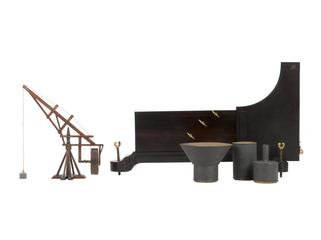Arms, maker and place of production unknown
Arms, maker and place of production unknown, but made during the mid-eighteenth century (1740-60) and owned by Stephen Demainbray. The rolling double cone was used in demonstrations of natural philosophy.
More
The only rolling double cone and arms made of brass of the three in the King George III Collection. It was itemised in the Queen's Catalogue and therefore believed to have belonged to Stephen Demainbray. Demainbray worked as superintendent at the King's observatory at Kew from 1768 and his collection of instruments and apparatus was absorbed into the King's own collection. The rolling double cone was used to demonstrate the paradox in which the cone can be made to appear to roll up the incline created by the arms when they are raised slightly at the open end. This demonstration was popular in courses of natural philosophy during the mid-eighteenth century and was first described in Lebourn's 'Recreations of Divers Kinds' in 1694.













